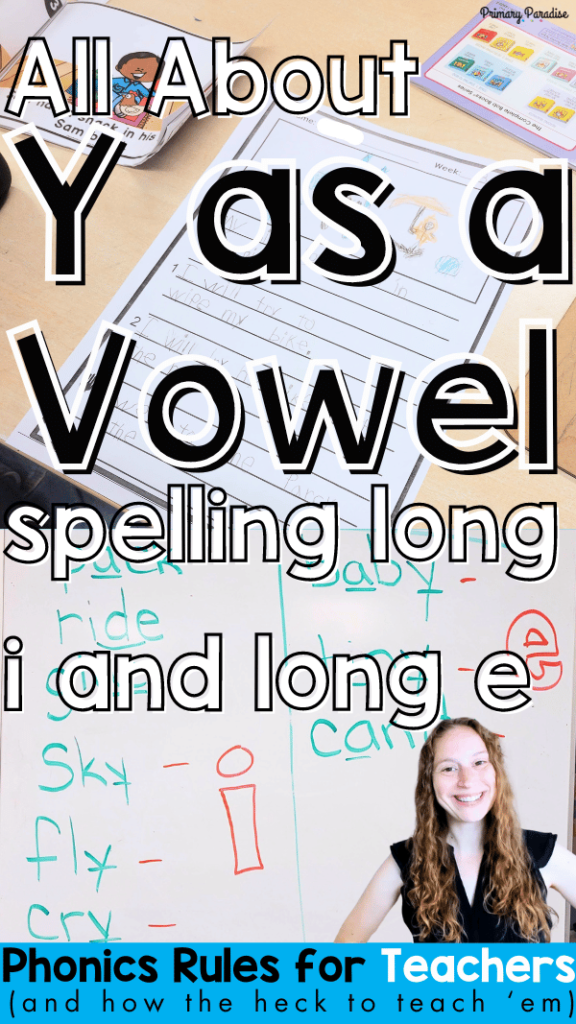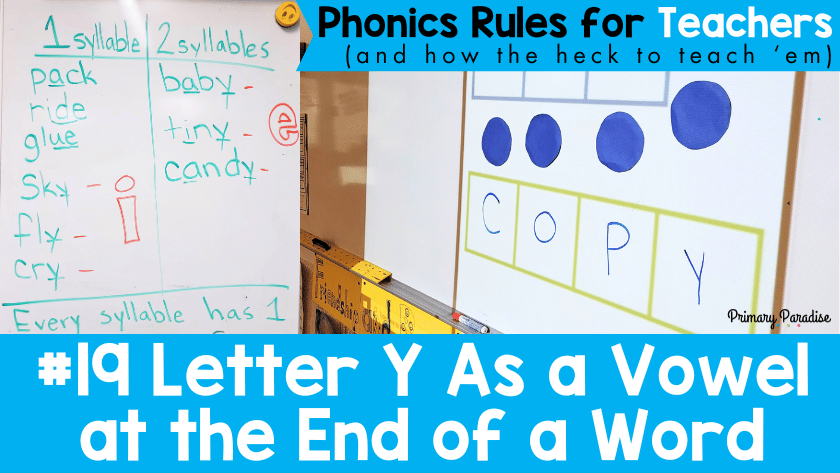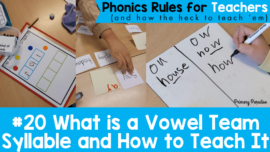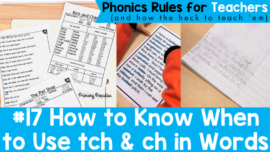Y as a vowel in English is more common than you might think. In fact, y spells vowel sounds more than it spells a consonant sound. Y often spells the long i and long e sounds, and it can spell the short i sound as well. In fact, y spells a vowel sound in 2041 words while it spells the consonant sound in only 57 words. How can you know where we find y spelling i and e and how to use it? Let’s take a look when we see y representing these vowels at the end of words in English and how to teach it to your students.
This is post 19 in my series Phonics Rules for Teachers (and How the Heck to Teach ‘Em). If you’d like to see previous posts, you can click here.
Would you rather listen or watch? Find a podcast version of this blog post or watch the video below.
When Y Spells long i
In English, words do not typically end with an i. This is true unless a word has been borrowed from another language (example: ski), it’s a slang word or a shortened version of another word (example: hi), or for the words you and I. For this reason, when we hear a long i sound at the end of one syllable word, it is usually spelled with a single y.
There are 128 words that have y spelling long i at the end of a root word. Some examples of this spelling pattern are: my, by, fly, sky, try and why.
These single syllable words end in a long vowel sound spelled by a single vowel letter, so they are open syllable words.
When Y Spells long e
In English, we can spell the long e sound with a single y at the end of a word with two or more syllables. This can include words that just end with a y such as baby, icy, carry, any, every, nobody, and angry. It can also include words with the suffix ly such as greedily, suddenly, nearly, scientifically, and fairly. Y spells long e more often than y spells long i. There are 1628 words where y spells long e at the end of the word. These syllables are open syllables.
Exceptions
While we usually spell long i with an y at the end of a one syllable word, there are some multisyllabic words where y spells i. Some examples are reply, multiply, and falsify. Sometimes when we have compound words we see this as well (a compound word is where we put 2 or more words together to create a new word). Some examples of this are: dragonfly or hereby.
Again, this is why, when we explain these spelling patterns to our students, we use words like most of the time or typically. If they know that y can spell both long i and long e, if they come to a word where the expected sound doesn’t fit, they can try the other possibility.
Adding endings to words ending in a single y
Understanding that y replaces an i or an e at the end of the word helps us understand why, when we add suffixes to these words, sometimes the y switches back to an i. If a word ends with a single y, and we need to add a suffix, there are some things to keep in mind.
- Two i’s can’t be next to each other in English.
- If the suffix begins with a letter other than i, the y in the root word switches to an i- examples: happy becomes happiness, busy becomes puppy becomes puppies, try becomes tries.
- If the suffix begins with an i, the y remains- examples: cry becomes crying, baby becomes babyish, study becomes studying
Exceptions
This rule actually has a large number of exceptions, but as you’ll see, it’s still a very small percentage. There are 14 words that keep their y when you’d expect it to change to i. This is only 1% of the words ending in y. These words are: buyable, buyer, dryness, flyable, shyer, shyly, shyness, slyness, slyer, slyest, spryly, spryness, wryness, and wryly. As you notice, many of these are the same root words with different endings.
How to Teach Y as a long i and e at the end of a word
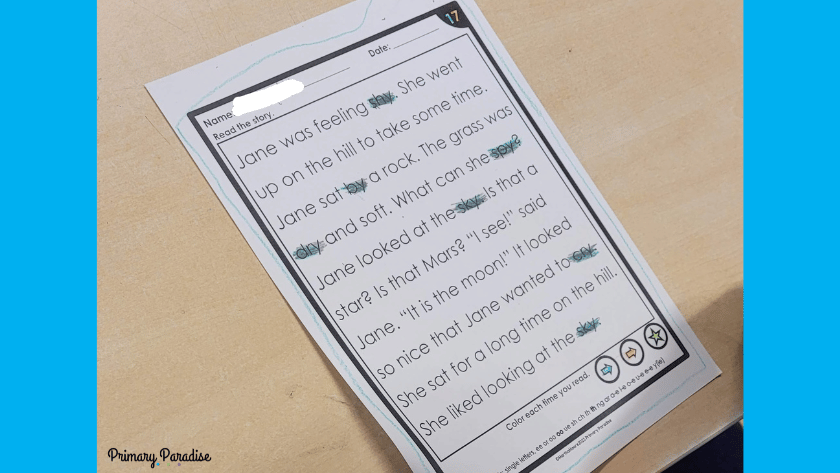
Teach y spelling i
I always say, when teaching phonics, that we should start with the most common and more simple sound. In this case, while y spelling long e is more common (1628 words for long e vs 128 for long i), it is also found in two or more syllable words. This means it’s the more complex spelling pattern. For this reason, begin by teaching that y spells long i at the end of a one syllable word.
Review open syllables
Start by reviewing what an open syllable is. Have students give examples, and list the words they say such as go, no, he, she, we. Then, say the word by. Ask students what sounds they hear- /b/ and /i/. Ask them to help you spell each sound. After writing the b, you can remind them that we’ve learned that words in English don’t end in i. Explain that, when we hear the long i sound at the end of a single syllable word, we often spell it with a y.
Have students brainstorm more words that rhyme with by and write them down as well. Some examples are: fly, try, cry, spy, sly, fry, and why. If they say words like pie or tie, you can write them down in a separate list. If you’ve already learned about silent e, you can remind them that we can also use a silent e to prevent words from ending in i.
Practice
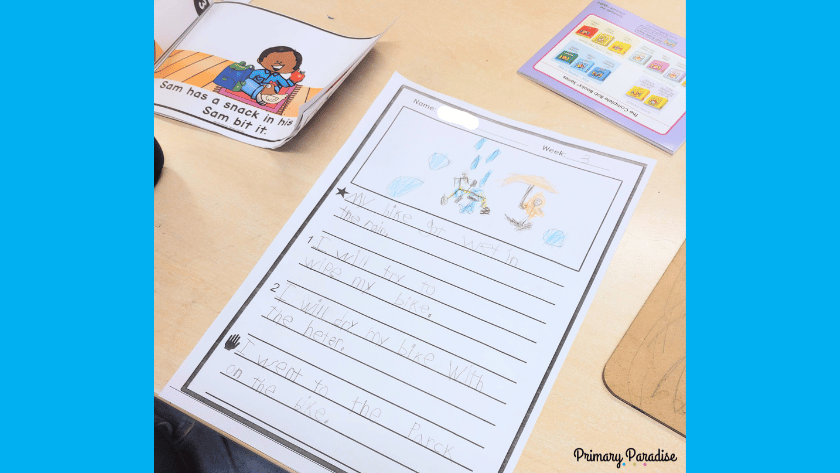
Once you’ve introduced and explained y spelling i at the end of a one syllable word, you can begin to practice this skill. You can add this to your daily sound drill to ensure students are reviewing this daily. Take some time to map words with this spelling pattern, read decodable texts, and have students create a targeted journal entry with this sound as well. (Find 12 ways to practice this and any sound here.) The more your students have the opportunity to read and write this new spelling pattern in context, the stronger their understanding will be.
Teach y spelling e

Once students are comfortable with y spelling i, you can teach them that y spells e at the end of words with two or more syllables. Write some words with y spelling i, and then write a two syllable words with y spelling e such as- tiny, baby, silly. Tell students that in these words, y is spelling the long e sound. Practice reading the words together, and explain that typically y spells long e at the end of a word with two or more syllables.
From there, you can again practice using any of these strategies until your students are comfortable and confident with this spelling pattern.
